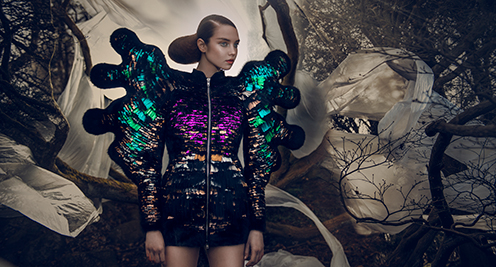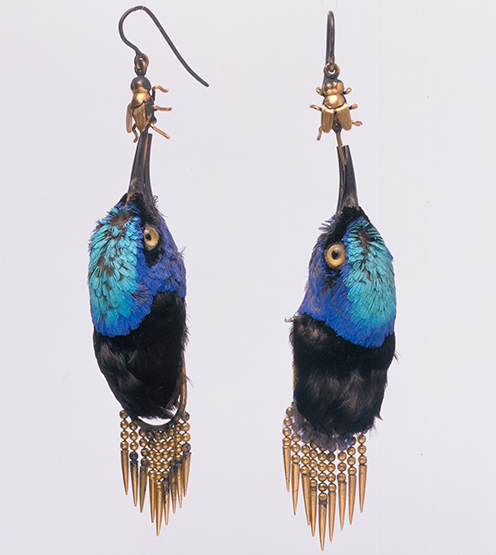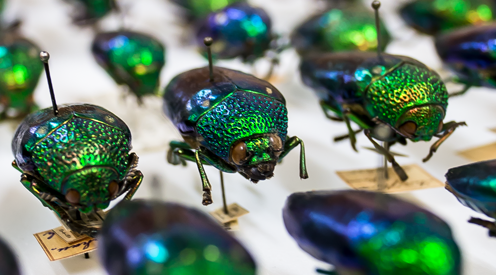FASHIONED FROM NATURE: New exhibition explores the relationship between nature and fashion
A dress woven by plant roots, 19th-century earrings made of bird heads, Emma Watson’s Calvin Klein dress made of recycled plastic bottles. These are just some of the many beautiful, inspiring and sometimes disturbing objects in Fashioned from Nature. The exhibition, which has received widespread critical acclaim, opens at the Natural History Museum of Denmark on 13 April. It explores the complex relationship between fashion and nature over the last 400 years, with a keen eye on how the fashion industry has looked to Mother Nature for both inspiration and raw materials. Our choice of clothing has always reflected our relationship with the world around us. Fashioned from Nature invites the public to re-examine the contents of their wardrobes. The exhibition is also highly optimistic, highlighting new ideas that pave the way for more sustainable production, such as a dress made from plastic shoreline waste.

FASHIONED FROM NATURE | Special exhibition at the Geological Museum | 13 APRIL – 1 SEPTEMBER 2019
Fashioned from Nature premiered at the Victoria and Albert Museum in London, and Copenhagen is the first stop on the tour. It features exclusive clothing and accessories on loan from the V&A, including an elegant cotton dress from 1869 adorned with sparkling green beetle wing cases. The Natural History Museum of Denmark adds its own perspective by presenting the garments alongside relevant and illuminating natural history objects from its own scientific collections.
“We want to inspire people and enable everyone to understand and protect the diversity of nature. This is our most sacred duty as a natural history museum – and the whole point of Fashioned from Nature. Never has an exhibition like this been more vital and relevant,” says Professor Peter C. Kjærgaard, director at the Natural History Museum of Denmark.
“The fashion industry has an enormous impact on our planet, with dire consequences for the diversity of animal and plant species. The situation is deeply serious. The exhibition focuses on both industrial production and individual consumption, and in doing so provides the public with an informed basis on which to act. At the same time, we also want to celebrate nature as a source of inspiration for beautiful and innovative design that will pave the way to a more sustainable future,” he adds.

Gems and toxic plant seeds
The Natural History Museum of Denmark houses approximately 14 million objects collected on 400 years of expeditions all over the world.
“We have the opportunity to bring to the original exhibition a unique extra dimension – natural history objects related to the history of fashion. For example, gemstones, colourful beetles, exotic bird feathers, amber, whalebone used in dressmaking and toxic plant seeds made into jewellery,” says Professor Nina Rønsted, curator at the Natural History Museum of Denmark.
“Our objects vividly relate the history, diversity and fragility of the natural world better than anything else does, and offer insights into the functions of these amazing colours, shapes and materials, which are used for pollination, seed dispersal, mating or self-defence.
The exhibition shows how the fashion industry has grown from around 1600 to the present day, its impact on nature, and how activists, environmentalists and modern designers advocate more responsible practices. This is the first exhibition to address fashion and sustainability in such a broad historical framework, at the same time it underlines the Natural History Museum of Denmark’s commitment to the United Nations Sustainable Development Goals.

Highlights
- Beautiful clothing from the world’s leading art and design museum, the Victoria and Albert Museum (V&A) in London.
- Fascinating objects from the Natural History Museum’s scientific collections related to the history of fashion, including colourful beetles, exotic bird feathers, stuffed hummingbirds used for ornamental purposes, whalebone used in dressmaking, and Nordic amber and toxic plant seeds made into jewellery.
- Exciting and innovative new textile products that already exist or are currently being developed, for example a dress made from plant roots.
- Trainers made of recycled plastic retrieved from the oceans, and other imaginative and inventive fashions created with respect for nature by a range of international designers, including Alexander McQueen, Jean Paul Gaultier Stella McCartney, Calvin Klein and Nike.
- Contributions from both established and new Danish design talents, highlighting the fact that Danish fashion is at the forefront in terms of both inspirational design and environmental awareness.
Contact
Nina Rønsted
Professor and curator
Natural History Museum of Denmark
University of Copenhagen
E-mail: nronsted@snm.ku.dk
Mobile: +45 23 81 12 03
Rikke Sanderhoff Mørch
Head of Communication
Natural History Museum of Denmark
E-mail: rsm@snm.ku.dk
Mobile: +45 30 50 66 21
